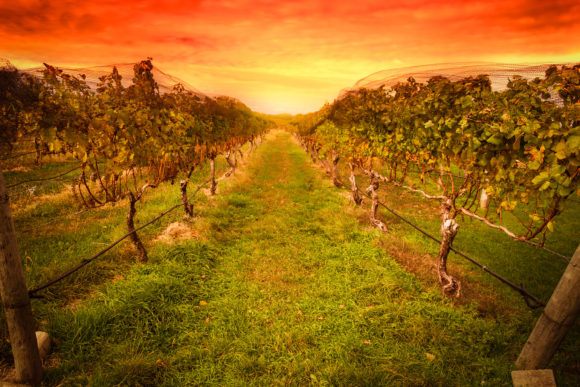Now that this October’s wine country fires have been contained, the ravaged San Francisco Bay area countryside can begin the rebuilding process. The effects of the wildfires, however, will be further reaching than the communities directly touched by the flames.
While the region will recover and grapes will be back on the vines next year, the property/casualty insurance industry responsible for funding much of this recovery will feel the effects for years to come.
Rising Premiums
One of the things that everyone should expect to see on the horizon is rate increases in fire prone-regions. With 43 people killed and nearly 9,000 structures destroyed, the magnitude of damage from the wildfires will signal to carriers that their outstanding fire risk has increased.
Some have already seen a trend in recent years of increased damages arising from wildfires, and thus more risk to insurers. From 1996 to 2015, fires and wildfires were less than 2 percent of insured catastrophe losses, roughly $7.3 billion during those years, according to ISO’s property claims services. That 20-year number, however, will potentially be exceeded by this October’s wildfires alone. Even excluding the recent wildfires, wildfires in 2017 occurring before October 6 had already burned 43 percent more acres than in the entire 2016 year, according to the National Interagency Fire Center.
Homeowners and businesses in fire-prone areas will see price increases when it comes time to renew their policies. For example, after a series of wildfires in San Diego in recent years, area homeowners saw multi-thousand dollar annual increases in their premiums, and in recent years some insurers have withdrawn from some high-risk areas by refusing to write new policies or declining to renew existing ones.
From 2007 to 2016, Allstate completely stopped writing new homeowners policies in California, stating that the decision was part of efforts to manage its catastrophic risk exposure. Other carriers have become increasingly selective about geographic areas in which they write.
After the October wildfires, expect to see more carriers questioning whether they want to stay in this high-risk market. For those homeowners and businesses who do keep their policies, during annual inspections they will likely see carriers vigorously enforcing fire safety standards and demanding more fire prevention measures before renewing.
Going forward, fewer carrier options and higher insurance costs in wildfire-prone areas will price more purchasers out of the insurance market in California and inevitably increase the number of people turning to the California FAIR Plan for coverage. The FAIR Plan program provides insurance as a last resort for those who cannot obtain coverage in the traditional market.
Another possible outcome of a coverage vacuum could be the rise of specialty policies and a larger local-carrier market in California. Something similar happened in Florida over the last decade as many large national players pulled back after an increase in catastrophic weather events. What rose in their place was a cadre of local providers specializing in the risks unique to the region.
Reinsurance Shuffle
These wine country wildfires coupled with the recent hurricanes across the south and in Puerto Rico will impact insurer reserves. JLT was already predicting that the combined effects of hurricanes Harvey, Irma and Maria would cost insurers $100 billion and create upward pricing pressures.
In addition to rate increases, the reinsurance market will get more active with carriers realizing that annual wildfire-related losses will likely be in the billions of dollars in coming years, not the millions they’ve been accustomed to, and adjusting their risk assumptions higher.
Although the reinsurance part of the market appears to have learned important lessons from the catastrophic years of 2001 (9/11) and 2005 (Katrina) in maintaining sufficient capital positions, between this year’s hurricanes, earthquakes and wildfires, nobody should be surprised at higher risk perceptions and loss expectations in the coming years as this 2017’s large-scale catastrophes have overwhelmed some reinsurers’ annual budgets. JLT, however, has predicted that these price increases will be modest compared to the jumps seen in the ’90s and ’00s because, due to lessons learned then, the reinsurance market has adjusted towards firms maintaining robust capitalization levels.
Big Data Models
Back in the day, insurance companies priced out fire risk by examining several risk categories, such as availability of fire hydrants, annual rain activity, ZIP code and local fire department ratings.
Nowadays, insurers determine fire risk based on a mapping programs that make individualized risk determinations from a given property’s slope position, proximity to other buildings, surrounding brush, local wind patterns, building materials, etc. Whereas 20 years ago neighbors could expect to pay similar rates, now the distance of a couple of blocks can lead to dramatically different premiums.
For the wine country wildfires, we are seeing several companies providing initial global loss estimates. These estimates are based on an amalgamation of satellite imaging, property databases, coverage rates, weather patterns and other information. The various data points are plugged into modelling software powered by proprietary algorithms to produce loss estimates.
Although the insurance industry has always been data-driven and has enthusiastically shifted towards using big data modelling, there is still some uncertainty about the predictive accuracy of the risk models offered by data analytics firms.
For example, AIR Worldwide estimated covered damages from the wine country wildfires in the range of $8 billion and $10.5 billion (these estimates from AIR were subsequently updated to between $8 billion and $10.5 billion). Yet RMS, a rival firm, recently upped its economic loss range from $3 to $6 billion to $6 to $8 billion, which they predict is representative of insured losses due to the high coverage level in the affected areas. Although both groups describe the limitations of their data and what factors are included, it is interesting that they have predicted dramatically different covered loss amounts.
This massive discrepancy highlights the limits of big data models, but will be a useful litmus test because, after all of the losses are accounted for, the accuracy, or lack thereof, of the various analytics firms’ predictive models will be more evident.
Also, depending on how the accuracy of these models turns out, there may be a stronger push within the industry to adopt more risk modeling technology such as brush mapping programs for predicting future risks. Moreover, due to the massive coverage of the wildfires, there will a lot of new data points to incorporate into the software, which will improve wildfire modeling accuracy.
Business Interruption Issues
Another issue likely to arise is whether a given business’s operations were sufficiently affected by the wildfires to activate coverage for contingent business interruption losses. It’s not a difficult case of business interruption when an insured’s property is completely destroyed by a wildfire, but a more difficult problem arises where an insured’s property is untouched by a fire, yet a supplier of components needed to conduct the insured’s business is burned to the ground and won’t be up and running again for months or years.
Due to the interconnected nature of the wine industry, we could see litigation regarding the scope of what constitutes a covered contingent BI, ultimately leading carriers to reconsider how they define or handle a business interruptions.
The specific wording for this sort of coverage can vary from policy to policy, and that wording can make all the difference. Furthermore, contingent BI terms typically fall under similar limitations to regular business interruption insurance.
Most BI policies require a “necessary suspension of operations” but do not define the term “suspension.” In California, appellate courts have interpreted that phrase to require a total cessation of operations. Under that interpretation, there is no coverage if the insured continues to operate despite a partial reduction or suspension in business activity.
In other states, however, similar policy language, such as “necessary interruption,” has been interpreted to require only that the business suffered some harm. As the California Supreme Court has not weighed in on this issue as it relates to traditional or contingent BI coverage, you can be sure there are creative lawyers out there currently trying to figure out how to get courts to lower the threshold for such coverage relating to these wildfires.
Cause and Response
One last thing to keep an eye on is what caused these wildfires. The direct impact on insurance companies may partly depend on whether these fires were caused by natural events or human negligence.
Although investigations into the cause of the wildfires are ongoing, there are already multiple lawsuits filed against Pacific Gas & Electric accusing the company of gross negligence.
With the fires contained, the next conflagration will be in the courts. Without even reading the tea — or if you prefer, grape — leaves, we may be able to refer to the next phase as “Grapes of Wrath.”
Topics California Catastrophe Carriers Natural Disasters Profit Loss Wildfire Data Driven Reinsurance Property Homeowners Market
Was this article valuable?
Here are more articles you may enjoy.



 Progressive Gains as Drivers Shop Around for Auto Insurance—Again
Progressive Gains as Drivers Shop Around for Auto Insurance—Again  Trump’s Bond Insurer Tells Judge Shortfall Is ‘Inconceivable’
Trump’s Bond Insurer Tells Judge Shortfall Is ‘Inconceivable’  JPMorgan Client Who Lost $50 Million Fortune Faces Court Setback
JPMorgan Client Who Lost $50 Million Fortune Faces Court Setback  North Carolina Adjuster and Son Charged With Embezzlement in Roof Jobs
North Carolina Adjuster and Son Charged With Embezzlement in Roof Jobs 


